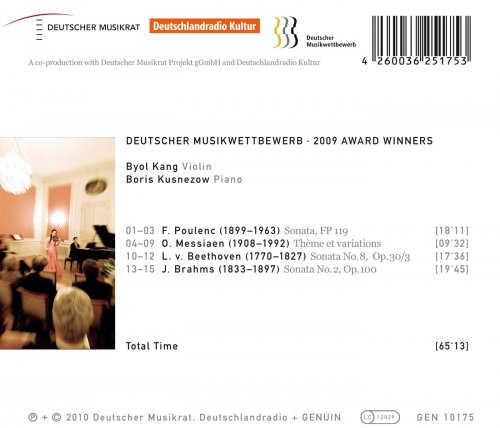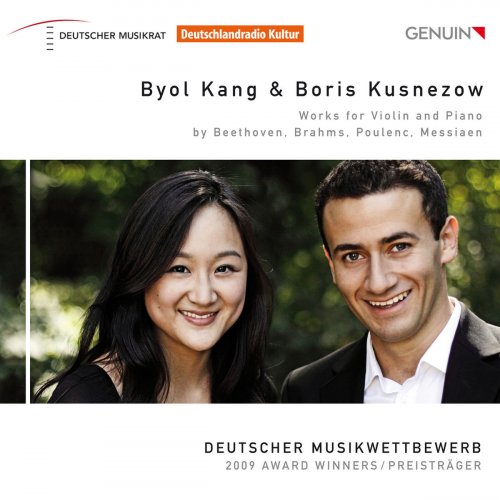
Byol Kang - Byol Kang & Boris Kusnezow (2010)
BAND/ARTIST: Byol Kang
- Title: Byol Kang & Boris Kusnezow
- Year Of Release: 2010
- Label: Genuin
- Genre: Classical
- Quality: FLAC (tracks+booklet)
- Total Time: 65:04 min
- Total Size: 268 MB
- WebSite: Album Preview

Tracklist:
01. I. Allegro con fuoco
02. II. Intermezzo: Tres lent et calme
03. III. Presto tragico
04. Theme: Modere -
05. Variation 1: Modere -
06. Variation 2: Un peu moins modere -
07. Variation 3: Modere, avec eclat -
08. Variation 4: Vif et passionne -
09. Variation 5: Tres modere
10. I. Allegro assai
11. II. Tempo di minuetto, ma molto moderato e grazioso
12. III. Allegro vivace
13. I. Allegro amabile
14. II. Andante tranquillo - Vivace - Andante - Vivace di piu - Andante - Vivace
15. III. Allegretto grazioso (Quasi andante)
Violinist Byol Kang and pianist Boris Kusnezow, having won not only individual prizes but an ensemble prize in the German Music Competition, appear as part of their award in a performance on this “Primavera Edition” CD. The program they’ve chosen represents a main course without appetizer or dessert—respectively, in a way, pastry and wine (French), and meat and potatoes (Austro-German).
The duo begins Poulenc’s sonata with a strong discharge of electricity, the energy of which they’re able to moderate in the more subtle melodic outpourings that follow (as did Arabella Steinbacher with Robert Kulek on Orfeo 739081, Fanfare 32:3), but it will later return. Those who admire the frenetic energy of Dong-Suk Kang’s version (Naxos 8.550276, which I like better than David K. Nelson seemed to in Fanfare , 15:5), as well as his haunting subtlety, may find that this performance sounds simply too supercharged (the identical suggestion I made about Midori’s performance with Robert McDonald on Sony SK 89699, Fanfare 26:3) and that the melodic sections lack tangy poignancy. The duo achieves a greater sense of repose in the second movement, and bustles energetically in the finale before the lightning bolt that transforms the atmosphere to one of brooding. So, of course, do Kang and Devoyon.
The theme of Messiaen’s Thème et Variations begins hauntingly, and the duo sounds appropriately exploratory and perhaps tentative. But as the intensity mounts through the piece (and especially at the end of the fourth variation), Kang and Kusnezow reveal an expressive side of their musical personalities that’s not at all overblown, and they focus a searing beam in the last variation, facilitating a nearly overwhelming climax. Isabelle van Keulen and Ronald Brautigam created an overwhelming sense of finality on Koch 3-6416-2 H1, Fanfare 20:5.
Their élan in the opening of Poulenc’s sonata returns in the opening of Beethoven’s, which, if it sounds more urgent than sunny here, nevertheless hardly appears lacking the enabling magic ingredient of growth and development. The trilled dialogue in the first movement and the concomitant rumbling in the bass grow almost menacing. The second movement displays their ability to play some of the most gracious melodies in the entire set of Beethoven’s violin sonatas with gemütlich warmth, reminding listeners that Kreisler and Rachmininoff chose this as one of three sonatas (with Schubert’s in A Major and Grieg’s in C Minor) for their recording sessions in 1928. And in the finale they’ve enlivened their already high spirits with flashing wit and pleasant surprises that should provide a surge of adrenaline even to those familiar with the work.
Brahms’s sonata allows the duo to expand both tonally and emotionally: After a first movement that presses strongly forward without losing a sense of the work’s autumnal coloration, those colors show themselves, as does a more tantalizingly playful side of the duo’s personality, in the slow movement. And especially in the last movement, the duo realizes Brahms’s rich textures, concluding the sonata with a display of almost decadent sumptuousness (or sumptuous decadence).
Kang’s violin, a Rogerius from 1678, may lack the ultimate power and strength, making the strongest passages occasionally sound strained, but Kang seems to make of it the best instrument it’s capable of being. In the slow movement of Beethoven’s sonata (and especially in the finale of Brahms’s), for example, the richness of the lower registers makes the flowing melodic material glow warmly, and the middle register allows her to take authoritative command in the first movement of Brahms’s work. For a meal without appetizer or dessert, this one, on the whole, seems surprisingly satisfying. Recommended as an auspicious debut by an appealing musical ensemble.
The duo begins Poulenc’s sonata with a strong discharge of electricity, the energy of which they’re able to moderate in the more subtle melodic outpourings that follow (as did Arabella Steinbacher with Robert Kulek on Orfeo 739081, Fanfare 32:3), but it will later return. Those who admire the frenetic energy of Dong-Suk Kang’s version (Naxos 8.550276, which I like better than David K. Nelson seemed to in Fanfare , 15:5), as well as his haunting subtlety, may find that this performance sounds simply too supercharged (the identical suggestion I made about Midori’s performance with Robert McDonald on Sony SK 89699, Fanfare 26:3) and that the melodic sections lack tangy poignancy. The duo achieves a greater sense of repose in the second movement, and bustles energetically in the finale before the lightning bolt that transforms the atmosphere to one of brooding. So, of course, do Kang and Devoyon.
The theme of Messiaen’s Thème et Variations begins hauntingly, and the duo sounds appropriately exploratory and perhaps tentative. But as the intensity mounts through the piece (and especially at the end of the fourth variation), Kang and Kusnezow reveal an expressive side of their musical personalities that’s not at all overblown, and they focus a searing beam in the last variation, facilitating a nearly overwhelming climax. Isabelle van Keulen and Ronald Brautigam created an overwhelming sense of finality on Koch 3-6416-2 H1, Fanfare 20:5.
Their élan in the opening of Poulenc’s sonata returns in the opening of Beethoven’s, which, if it sounds more urgent than sunny here, nevertheless hardly appears lacking the enabling magic ingredient of growth and development. The trilled dialogue in the first movement and the concomitant rumbling in the bass grow almost menacing. The second movement displays their ability to play some of the most gracious melodies in the entire set of Beethoven’s violin sonatas with gemütlich warmth, reminding listeners that Kreisler and Rachmininoff chose this as one of three sonatas (with Schubert’s in A Major and Grieg’s in C Minor) for their recording sessions in 1928. And in the finale they’ve enlivened their already high spirits with flashing wit and pleasant surprises that should provide a surge of adrenaline even to those familiar with the work.
Brahms’s sonata allows the duo to expand both tonally and emotionally: After a first movement that presses strongly forward without losing a sense of the work’s autumnal coloration, those colors show themselves, as does a more tantalizingly playful side of the duo’s personality, in the slow movement. And especially in the last movement, the duo realizes Brahms’s rich textures, concluding the sonata with a display of almost decadent sumptuousness (or sumptuous decadence).
Kang’s violin, a Rogerius from 1678, may lack the ultimate power and strength, making the strongest passages occasionally sound strained, but Kang seems to make of it the best instrument it’s capable of being. In the slow movement of Beethoven’s sonata (and especially in the finale of Brahms’s), for example, the richness of the lower registers makes the flowing melodic material glow warmly, and the middle register allows her to take authoritative command in the first movement of Brahms’s work. For a meal without appetizer or dessert, this one, on the whole, seems surprisingly satisfying. Recommended as an auspicious debut by an appealing musical ensemble.
As a ISRA.CLOUD's PREMIUM member you will have the following benefits:
- Unlimited high speed downloads
- Download directly without waiting time
- Unlimited parallel downloads
- Support for download accelerators
- No advertising
- Resume broken downloads


